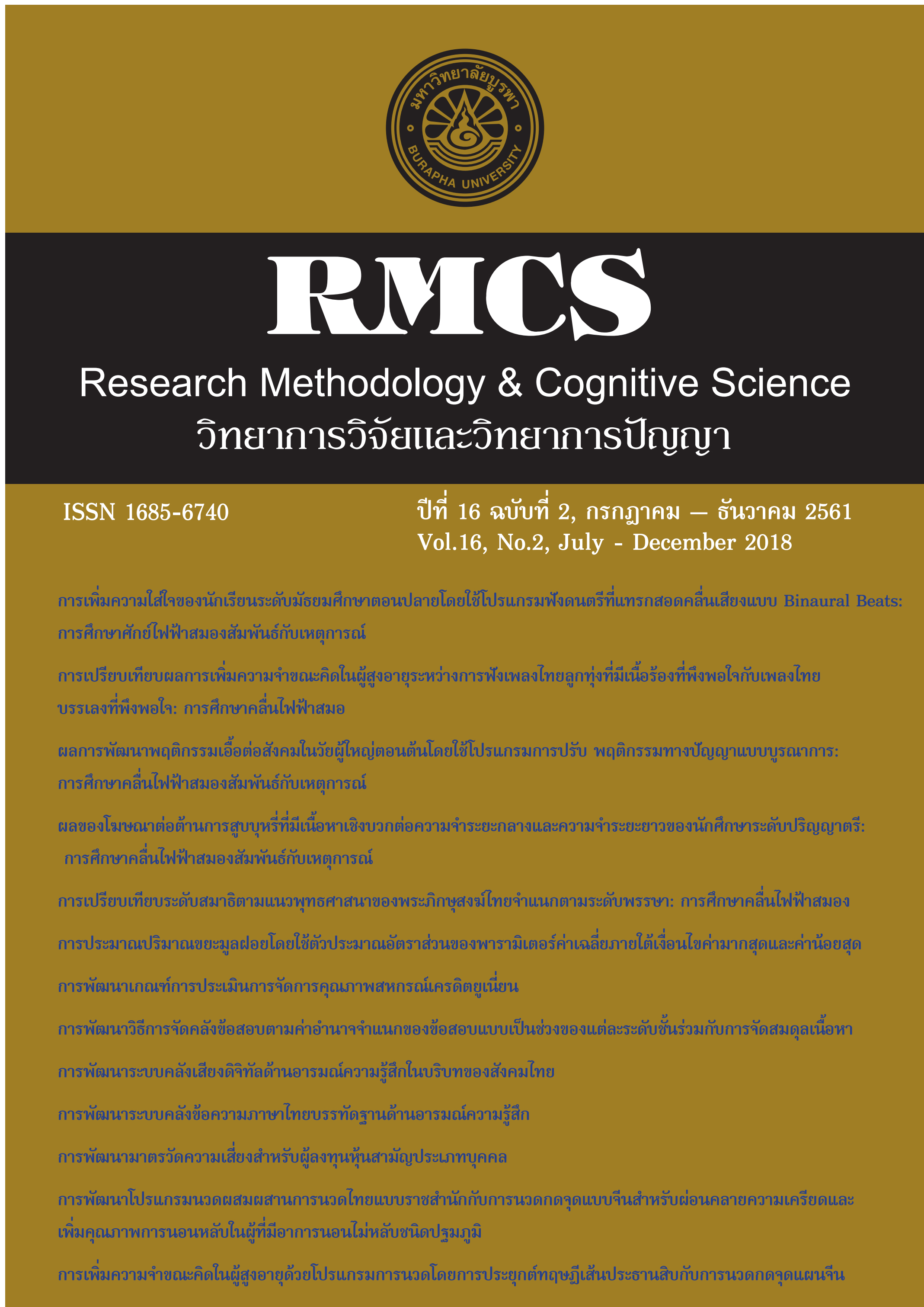Development of the Affective Norms for Thai Words (THAI-ANT) Bank System
Main Article Content
Abstract
Texts in style of phrase are a part of language. They are instruments for human communication and stimuli that convey emotion, cognition, and attitude. The objectives of this research were (1) to analyze the Thai texts of affective and to assess the quality of the affective norms for Thai texts via content validity, a discrimination index, the mean and standard deviation of Thai texts, the reliability of Thai texts for three emotional domains (i.e. valence, arousal, and dominance); and (2) to develop the affective norms for Thai texts (Thai-ANT) bank system. The sample used in this study involved Thai volunteers who lived in Thailand, and were aged between 18 and 60 years, regardless of gender, educational level, and marital status. The sample composed of 400 people. The Self-Assessment Manikin Scale were employed in the study, and t-tests were used to analyze the data.
It was found that;
- A total of 382 Thai affective texts were validated and retained. These texts were classified along the three emotion dimensions: 1) 137 valence texts (77 pleasant, 22 neutral, and 38 unpleasant), 2) 119 arousal texts (51 exited, 46 neutral, and 22 calm), and 3) 126 dominance texts (15 uncontrol, 95 neutral, and 16 control).
- A user-friendly computerized program of the Thai Affective Texts (Thai-ANT) Bank System was developed as an online computerized program for housing the validated Thai affective texts had quality at the good level.
Article Details
References
สุชีรา ภัทรายุตวรรตน์. (2552). คู่มือการวัดทางจิตวิทยา. กรุงเทพฯ: สำนักพิมพ์ เมดิคัล มีเดีย.
อภิชัย มงคล, ยงยุทธ วงศ์ภิรมย์ศานติ์, ทวี ตั้งเสรี, วัชนี หัตถพนม, ไพรวัลย์ ร่มซ้าย และวรวรรณ จุฑา. (2560). การพัฒนาและทดสอบดัชนีสุขภาพจิตคนไทยฉบับใหม่. เข้าถึงได้จาก http://www.dmh.go.th/Abstract/abstract/abstract_detail.asp?code=100090
โอภาส เอี่ยมสิริวงศ์. (2560). ระบบฐานข้อมูล (Database System). กรุงเทพฯ: ซีเอ็ดยูเคชั่น.
Anastasi, A. (1988). Psychological Testing. New York: Macmillan.
Bradley, M. M., & Lang, P. J. (1994). Measuring Emotion: The Self-Assessment Manikin and The Semantic Differential. Journal of Behavior Therapy and Experimental Psychiatry, 25(1), 49-59. Doi: 10.1016/0005-7916(94)90063-9.
Bradley, M. M., & Lang, P. J. (1999). International affective digitized sounds (IADS): Stimuli, instruction manual and affective ratings (Tech. Rep. No. B-2).
Cureton, E. E. (1966). Simplified formulas for item analysis. Journal of Educational Measurement, 3(2), 187-189.
Elliott, G. (2004). Global business information technology: An integrated systems approach. Ontario: Pearson Addison Wesley.
Gerrig, R. J., & Zimbardo, P. G. (2002). American Psychological Association: Glossary of Psychological Terms: Pearson Education, Education, Incorporated (COR).
Hair, J. F., Jr., Black, W. C., Babin, B. J., Anderson, R. E., & Tatham, R. L. (2006). Multivariate Data Analysis (6th ed.). Upper Saddle River, New Jersey: Prentice Hall.
Imbir, K. K. (2016). Affective Norms for 718 Polish Short Texts (ANPST): Dataset with Affective Ratings for Valence, Arousal, Dominance, Origin, Subjective Significance and Source Dimensions Approach. Frontiers in Psychology, 7, 1. doi: 10.3389/ fpsyg.2016.01030.
Lopez, A. T. (1998). The item discrimination index: Does it work. Rasch Measur Transact, 12(1), 626.
Mehrabian, A., & Russell, J. A. (1974). The basic emotional impact of environments. Perceptual and Motor Skills, 38(1), 283-301.
Murphy, K. R., & Davidshofer, C. O. (2005). Psychological testing: Principles and Applications (6th ed.). New Jersey: Pearson, Prentice Hall.
Ngamprom, C., Chadcham, S, & Wongupparaj, P. (2017). Development of the Affective Norms Words (THAI-ANT) Bank System. Research Methodology & Cognitive Science, 15(2), 162-178.
Osgood, C. E., Suci, G. J., & Jannenbaum, P. H. (1957). The Measurement of Meaning. Illinois: University of Illinois Press.
Redondo, J., Fraga, I., Comesaña, M., & Perea, M. (2005). Estudionormativo del valor afectivo de 478 palabras españolas. Psicológica, 26, 317-326.
Schmidtke, D. S., Schroder, T., Jacobs, A. M., & Conrad, M. (2014). ANGST: Affective Norms for German Sentiment terms, Derived from the Affective Norms for English Words. Behav Res Methods, 46(4), 1108-1118. doi:10.3758/s13428-013-0426-y.
Sripornngam, T., Chadcham, S, & Sudhasani, S.,. (2017). Development of the Affective Picture Bank System. Research Methodology & Cognitive Science, 13(2), 57-70.
Stadthagen-Gonzalez, H., Imbault, C., Sánchez, M. A. P., & Brysbaert, M. (2016). Norms of valence and arousal for 14,031 Spanish words. Behavior Research Methods, 49(1), 111-123. University of Florida. (2017). Retrieved from http://csea.phhp.ufl.edu/media.html
Wundt, W. (1896). Gundriss der Psychologie [Outlines of psychology].Leipzig, Germany: Entgelmann.

